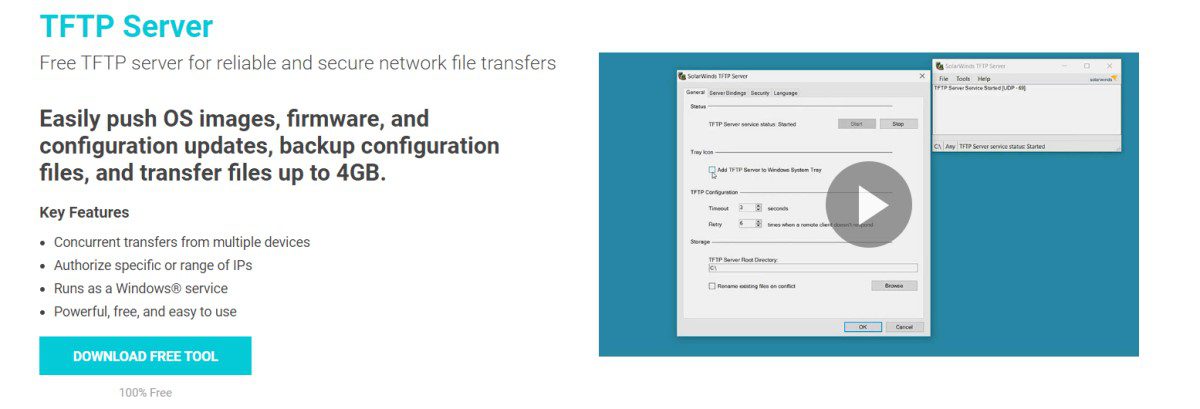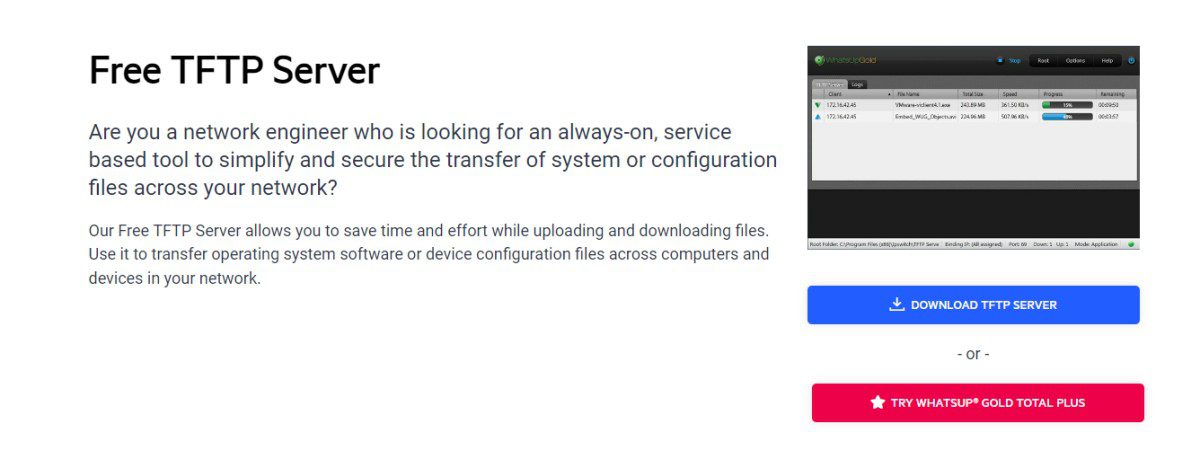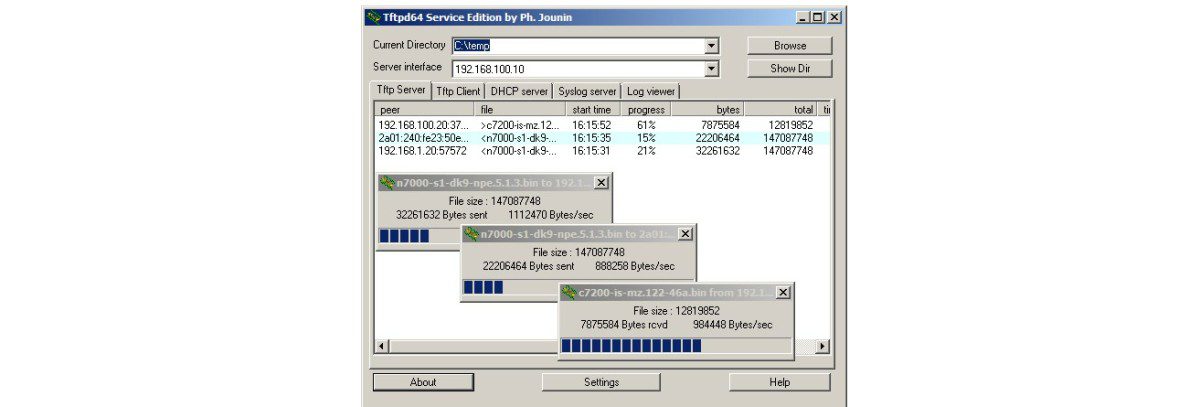Top 5 TFTP Servers for Windows
TFTP servers provide a simple, convenient, and efficient way to connect to your network resources and transfer files, install configurations and updates, back up resources, and more.
It's a great option over other options like FTP due to its simplicity, speed, and other benefits, especially if you want to use it on your organization's or home's network.
But what is this TFTP?
And what do you mean by TFTP server?
Let's break down these concepts in detail along with their benefits and use cases. This post will also list some of the best TFTP servers for Windows.
What are TFTP and TFTP Servers?
Trivial File Transfer Protocol (TFTP) or Trivial FTP is a simple version of the popular File Transfer Protocol (FTP) specified in RFC 1350.
TFTP servers use TFTP and are used to transfer small files from one system to another using the User Datagram Protocol (UDP). You can also use TFTP to back up networks, boot your computer without a disk, and more. TFTP servers are mainly used in devices such as routers, mobile phones, etc.
However, this protocol lacks built-in security controls; therefore, it does not require authentication. This is also the reason why it is mostly used in internal networks.
Moreover, the lack of security can be compensated by comparing the signatures of transferred files with known keys or values. TFTP is ideal for use when your system's CPU or memory capacity is not suitable for other protocols such as FTP.
FTP vs. TFTP

In FTP, you can transfer files from one system to another or from one host to another using TCP, and it works with port numbers 20 and 21. However, when transferring files, you may encounter some problems, such as security or a different directory or name file. on different systems or hosts.
With TFTP you can transfer data between server and client without using FTP. Instead, it uses UDP. Its software is smaller and runs on port number 69.
Also, FTP is more complex than TFTP. Hence, if your usage is minimal, you can quickly get started with TFTP.
FTP includes many messages or commands, but TFTP only uses 5 messages.
FTP may be slower, but TFTP is faster.
FTP requires authentication to establish communications; TTFP is not.
FTP is more suitable for remote users to upload and download files. On the other hand, TFTP is suitable for transferring configurations between network devices.
How does a TFTP server work?

Since the TFTP server is running on port number 69 to establish a UDP connection, you must open a server socket on the server's IP address on UDP port number 69. When the connection is established, the client will send a request to your server. These message requests can be sent in different types. The TFTP server will then split this message into different blocks of 512 bytes each. Also, the last block of each file is less than 512 bytes. This is done to help the recipient interpret the last block of the message.
In addition, each block must be sent as a TFTP data request, and the rest will be assigned a TFTP number. But you must make sure that each block is stored separately in the UDP message.
If the last block size is at least 512 bytes (except for a multiple of 512), the user sends another block consisting of null bytes. This will indicate to the recipient that the data transfer is complete. In addition, the TFTP server will start the check and suspend protocol and will send blocks one by one. This protocol will also require confirmation from the sender, and only after that the next blocks will be sent.
However, if an acknowledgment is not received within the given period, the sender will push it again until it is acknowledged.
Using TFTP Servers
TFTP is useful in many use cases:
Device bootstrap

TFTP servers are used during the device boot process to download configuration files and operating systems. Also, you can copy the configuration file between two nodes if they are on the same network.
Additionally, devices that obtain an IP address via the Bootstrap Protocol (BOOTP) or Dynamic Host Configuration Protocol (DHCP) can use this TFTP protocol to easily download configuration files and bootstrap images. In addition, you can use TFTP with FTP for various purposes, such as FTP to download a system image and TFTP to download a boot image.
Transferring small files
You can transfer smaller files on the local network using UDP. It requires less network resources and is easier to send firmware updates and files to network devices. You can even save network resources by easily updating firmware and devices.
Network administration
TFTP is widely used for network administration in large intranets. Since it does not require authentication and can be susceptible to attacks, organizations use it inside their network to transfer data, send updates, etc. Thus, only their internal team and members can use the services while remaining protected from the outside world ( Internet), which is open to everyone.
home furnishings

Houses require fewer data transactions or files and updates to be sent. That's why TFTP is suitable for home environments. This will help you keep your personal data safe by reducing the vulnerability and attack surface.
But if you need to transfer large files between incompatible operating systems, you can use a TFTP client and server.
Why use TFTP servers?
Simplicity
TFTP servers are easy to use for network administrators and engineers. This helps them easily connect to your network resources, troubleshoot and manage them, as well as create backups and update them in a timely manner. In addition, even if something goes wrong, you can easily replace the hardware and load the configuration.
Saves time

TFTP servers can help you distribute firmware updates directly to various devices from a central location. This means you don't have to spend hours on a single task; instead, you can use a TFTP server to automate the entire process.
Faster
Compared to FTP, TFTP servers are relatively faster. You can connect to your network resources faster and get your work done, like updating or transferring files faster. This helps improve the productivity of your engineers and administrators.
So, are you ready to take advantage of these benefits?
If so, here are some good options for TFTP servers.
solar winds
Get a SolarWinds TFTP server for free for secure and reliable file transfers. It is an easy to use and powerful solution for transferring all your files.
You can easily send configuration updates, OS images, back up configuration files and firmware, and transfer files up to 4 GB in size. With this solution, you can transfer files from multiple systems at the same time without any confusion or errors. In addition, it may allow transmission from a specific IP address or range of IP addresses.

These TFTP servers can be run as a Windows Service. This will simplify and secure your network transmissions and help you easily control change management and network configurations. This award-winning SolarWinds TFTP solution is 100% free for basic features such as device firmware and OS updates, and network configuration backups.
However, if you want to use advanced features, it starts at $1,738. It will include:
- Extended version backup, search and device configuration
- Advanced Device Configuration Script and Template Management
- High scalability with multi-user administration
- Configuration audit
Start a 30-day free trial to see how it works, or get started with the free version.
WhatsUp Gold
If you are looking for an always-on service tool to secure and facilitate file transfers on your network, WhatsUp Gold TFTP Server is a good option. If you want to transfer configuration files or system files, you can use this free solution.
This simple and effective solution will help you save effort and time when uploading and downloading files. In addition, you can use it to transfer your device configuration files and OS software between your devices and computers over your network.

WhatsUp Gold TFTP servers make it easy to back up your entire environment. It comes with many features such as:
- Backup network configs
- View devices
- Copying data on the network
- Download configurations back to your devices over the network
- Supports Windows Vista, XP, etc.
This simple software is easy for administrators to use to manage existing equipment on their network. It also helps ensure that in the event of a network or router switch failure, you can easily replace the hardware with a similar one and upload the configuration to the system. It has a clear, robust and visually appealing GUI based interface.
TFTP-server haneWIN
haneWIN TFTP Server is a multi-threaded RFC 1350 based server that provides high reliability and performance in data transfer. It is implemented as a Windows solution and supports various versions of Windows. The server enables the TFTP multicast operation specified in RFC 2090.
The TFTP Server includes a unique, intuitive control panel to access all services. You can also directly receive data to other applications using the channel parameter. haneWIN TFTP supports both legacy and current versions of Windows from XP to 10. You can also run it in the background as a service on Windows 95, 98, and 2000 without even logging in.
The haneWIN TFTP server secures data for profiles based on the requested operation, file directories, and the IP address the server is using. Also, configure your server to transmit data on different UDP ports depending on your network traffic and firewall settings.
Tftpd64
Tftpd64 is a 64-bit French Windows-based utility with a running TFTP server. It is a lightweight, free and open source application that supports IPv6 with a TFTP client and TFTP servers. It also includes DHCP, SNTP, DNS and Syslog servers.

Both the TFTP server and client fully support TFTP parameters such as timeout, block size, and tsize to provide the highest level of data transfer performance. It also includes some advanced features like security launcher, directory tool, interface filtering, etc.
In addition, early acknowledgments and progress indicators increase the throughput and utility of the TFTP protocol for the TFTP server and client. In addition, the DHCP server includes unlimited static or automatic assignment of IP addresses.
You can also implement Tftpd64 as a windows service. It is identical to its other variant, Tftpd32, which is compiled as a 32-bit application.
Istochnikforz
Sourceforge is a multi-threaded TFTP server for Windows/Unix. This free and open source software starts a service or daemon. You can also get a single port version of it.

This TFTP server supports almost all standard features, total size (tsize), interval time, block size, block number change for large files, process owner other than root, and more. It is also useful for advanced logging and historical logging.
The Sourceforge TFTP server can define server ports and interfaces and supports client port ranges. It takes up less space and is suitable for system administrators and other advanced end users.
Summary
If you are looking for a simple, fast and easy solution for sending files, installing updates and configurations, or booting your device, TFTP is a good solution. It is best suited for LANs and intranets as it does not require authentication and is easy to use by your administrators and engineers.
Thus, you can choose any of the above mentioned TFTP servers based on your preferences and take advantage of its features and capabilities.